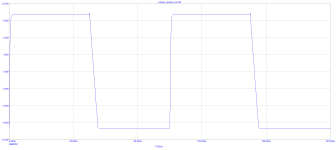Please, not with such an C2 value...Has anybody used this, so far?
This will kill all a JFET magic...
Simulation or measurement?
There have been hundred built. See that thread.
And about measurement: This is another discrete one in real life, it is a diamond base BJT input stage at 1V input (I have not finished the FE2022 yet), I made a few weeks ago.

And about measurement: This is another discrete one in real life, it is a diamond base BJT input stage at 1V input (I have not finished the FE2022 yet), I made a few weeks ago.
"Good performance" is relative to your selection criterion. If you need low voltage offset this is not a good performer! I suspect the common-mode distortion is also high as JFET inputs are renowned for this without suitable mitigation: https://www.ti.com/lit/an/slyt595/slyt595.pdfHere is a basic opamp with good performance.
JFET input and can be used with single or dual supply.
Max 30V single or +/-15V supply.
Can be used as a preamp or whatever you need.
View attachment 1469666
For less money you can have a better JFET opamp in a single package, so its really an exercise in design.
Actually, it's all just old hat, but having a small functional gearshift in your back pocket is handy:
simple dis op amp
Please don't be put off @lineup, even Pavel is only reinventing the wheel.
I like your ideas
HBt.
simple dis op amp
Please don't be put off @lineup, even Pavel is only reinventing the wheel.
I like your ideas
HBt.
@lineup

Perhaps you would also like to take the above (not unknown) approach? As a buffer, you can then attach a diamond or jFet symmetrical source follower or another type of push-pull output stage ...
With a sufficient quiescent current, we are then in direct competition with Pavel's DIS PRE in the nth version.
I love the diversity of species and the variety of evolution.
HBt.
Perhaps you would also like to take the above (not unknown) approach? As a buffer, you can then attach a diamond or jFet symmetrical source follower or another type of push-pull output stage ...
With a sufficient quiescent current, we are then in direct competition with Pavel's DIS PRE in the nth version.
I love the diversity of species and the variety of evolution.
HBt.
Do you remember Holger Barske?Pavel's DIS PRE in the nth version.
https://www.scribd.com/doc/258023430/KLANG-TON-2007-04-pdf
(page 62 and 63) Klang+Ton 04/2007
and on German forum
https://www.analog-forum.de/wbboard/index.php?thread/31295-dispre/&pageNo=1
I know who Holger Barske is - and I also remember the high-end trade fair in Frankfurt in the 1990s. Yes, the whole circus and circle is not unknown to me. But why should I remember Mr. Barske now?Do you remember Holger Barske?
I know the K&T article and at the time I thought the circuit was a bit bland, to put it kindly. At the time, I immediately remodeled it. If you are interested in my thoughts on the K&T-DIS-PRE at the time, I could look for my notes on this project.
Dear Pavel,
I just say:
we reinvent the wheel every day.
The most important motto is:
there are no secrets.
I think Mr. H. Barske agrees with this immediately.
HBt.
We all know that. However, to me - it is important to complete the projects with a reliably working sample, tested under all possible conditions, regarding load, temperature etc. Not just to put thoughtlessly any circuit which comes to one's mind, without understanding how it works and without anticipating possible issues. People may try to build ..... and there is a big difference between simulator world (especially that of cheap simple versions) and the real world conditions. That's why I really do not like hot potatoes suggestions.we reinvent the wheel every day.
Simulation, however that circuit is so simple that real life result will be the same, due to dissimilar +I and -I charging the C2 compensation capacitance (220pF is too much), which is the limit for resulting dv/dt and +SR and -SR are thus different. Higher current of U7 CCS would help.Simulation or measurement?
There have been hundred built. See that thread.
And about measurement: This is another discrete one in real life, it is a diamond base BJT input stage at 1V input (I have not finished the FE2022 yet), I made a few weeks ago.
It is not difficult to get it with preamp with a diamond buffer, like in the real world measurement below, with a 100kHz square.
I know the K&T article and at the time I thought the circuit was a bit bland, to put it kindly.
That bland circuit is still on my web page, please feel free to check it:
https://pmacura.cz/dispre_en.html
IMO it was something quite different from those days usual designs. Not the kind of "reinventing the wheel" 😉.
220pF clobbers a JFET?Please, not with such an C2 value...
This will kill all a JFET magic...
220 pF totally drops feedback loopgain and output stage HF distortion rises to the moon.220pF clobbers a JFET?
- Home
- Source & Line
- Analog Line Level
- Basic Discrete JFET Opamp with good performance
